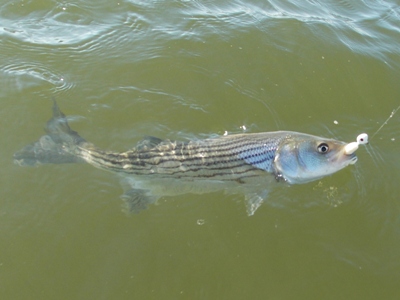
In the Chesapeake Bay, school sized striped bass, known locally as “rockfish” are targeted by many anglers. School striped bass are caught using a variety of methods including trolling, chumming, bottom fishing, light tackle jigging, casting artificial lures, and fly fishing.
In late September or early October, anglers begin deep trolling for school rockfish throughout much of the Chesapeake Bay. This technique is also effective for catching bluefish, trout, flounder, Spanish mackerel, and other species.
Trolling in the manner described can be hard work to but the results are very consistent. When deep trolling for school class rockfish, slow speeds are preferred, usually 2 to 3 knots. To reach fish on the bottom, some anglers use special trolling outfits spooled with #30 monel wire. Each wire line outfit is equipped with a 3 way swivel.
A 24 or 28 oz. drop sinker is added on 3-4 foot section of #30 mono. The third part of the swivel gets a 20-30 foot leader with either a single lure or a pair of bucktails. The leader is less likely to tangle if it is made of #50 or #80 mono. If the area trolled is full of snags, the leader may need to be #30 in order to sacrifice it and get the wire back in the event of a hang-up.
Jigs used for deep trolling are usually 1/2 to 3 oz. in various colors. A shad body or curly tail worm is added to the jig. White and chartruece are among the most popular colors for jigs as well as soft plastic bodies.
The first rig is dropped slowly until it “thumps” on the bottom and additional line is let out until the rig constantly thumps in 40′ of water. In depths over 40′ the rig may not reach the bottom. A second rig is also dropped down until it thumps once, then put in gear. The rig will quickly rise to a level a bit above the bottom.
This method keeps proper spacing of the two wire rigs with one now at or near the bottom and the other just above. A little practice is required to get proficient at trolling these without tangles. Watching the line guide on the reel is one way to get an idea of how much line each rig has out.
This technique is quite effective and will catch rockfish, trout and bluefish. The deep rig which is constantly thumping normally catches the most fish, especially if the rig uses tandem jigs. When rigging tandem jigs, the two jigs must be connected to a 3 way swivel by unequal distances. Typically, one jig is set about 18 inches and the other about 30 inches from the swivel.
In addition to wire line rigs, additional lines can be trolled on outriggers, planer boards, gunwale mount rod holders, or roof mounted rod holders. A typical spread might include a single long line (200 feet+), rigger lines at 150 and 180 feet, and two deep wire lines. To minimize tangles, the lines should be set out in a specific order: center line, longer rigger line, shorter rigger line, deeper wire line and shallower wire line.
The longer lines also get paired jigs but without dropper or inline sinkers. The distance of the first jig to the 3 way connection should be about half that of the distance from the 3 way to the second jig. Typically this amounts to about 18 and 36 inches. The shorter front jig can be larger and heavier than the trailing jig. Similarly, the front jig may get a larger shad body than the rear. Both jigs combined will weigh 5 to 10 oz. and will run up to 30 feet deep depending on boat speed, current, line out and combined lure weight.
This type of spread puts lures at a variety of depths in order to cover the entire water column. If the fish prefer a certain depth, anglers can make adjustments to move the other lines toward the preferred depth. There are several variations to the basic trolling pattern. If bluefish are plentiful, small spoons can be added, which hold up better.
This method is most often productive when fish are schooled along channel edges, especially where strong currents and tidal rips exist. In Tangier sound, productive areas occur from Deal Island southward to Tangier Light, Crisfield Artificial Reef, Kedges Straits, the Mud Leads, and buoys 62, 72A, 72, and H.S. buoy in the bay proper.
Rockfish can also be caught near working gulls. By trolling slowly, anglers are able to idle among schools of fish without spooking them. One of the advantages of deep trolling is its continued effectiveness after fish are spooked from the surface. Inevitably, one or more boaters will appear and plow thru the fish at high speed, sending the fish deep. This is all part of the challenge of fall striped bass fishing.
For more striped bass fishing information, see our articles on shallow water trolling, light tackle jigging, trophy striped bass fishing, umbrella rigs, daisy chain rigs, and trolling with wire line.